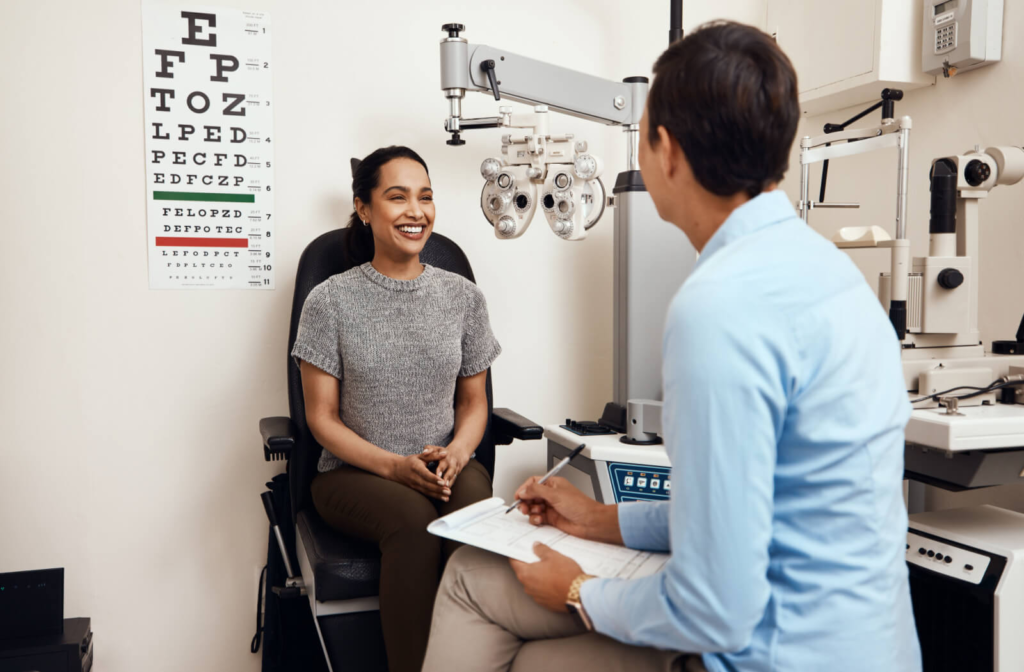You may think that choosing sunglasses doesn’t matter, but they have features that can make your vision clearer, your eyes more comfortable, and healthier. Some of the most popular and beneficial sunglasses include polarized lenses. They help eliminate glare, filter out harsh light, and come in a variety of styles.
If you have a pair of sunglasses and are unsure if the lenses are polarized, there are some simple tricks you can try to confirm it once and for all. You can identify polarized lenses by holding them up to a reflective surface, a computer screen, or comparing them with other polarized sunglasses. Your eye doctor is also a great resource for helping you identify and choose polarized, UV blocking sunglasses.
What Are Polarized Sunglasses?
Polarized sunglasses, sometimes called anti-glare, help reduce squinting and eye strain from reflected light. When light reflects off a horizontal surface, the beams scatter horizontally, affecting color perception and whitening out your vision.
You may notice glare off the hood of your car when driving, when you’re spending the day close to water, or when playing outdoor sports. There’s nothing worse than missing a goal during an outdoor soccer game or losing track of the volleyball at a beach tournament because of the sun’s rays.
Polarized sunglasses can help counteract glare while reducing your need to squint and strain your eyes.
How Do Polarized Sunglasses Work?
Typically, light bounces off several angles before it reaches your eye, but light is much more intense when it reflects off a single horizontal surface. A special chemical coating is applied to the lenses in a vertical pattern, creating a polarized effect on sunglasses.
A vertical orientation is key to blocking the horizontal light that causes irritating glare by allowing only vertical light waves to pass through the lens. The result is clearer, sharper, detailed vision in even the brightest conditions.
Are Polarized Sunglasses Better Sunglasses?
Polarized lenses have many benefits for your eyes, but these sunglasses aren’t designed for low-glare environments.
The advantages of polarized sunglasses include:
- Increased comfort
- Clearer vision
- Sharpened contrast and accurate color vision
- Eye strain and fatigue prevention
In some cases, polarized lenses aren’t the best choice, including:
- Viewing LCD screens and digital displays, such as on the dashboard of your car and smartphones
- Driving at night because some polarized lenses have a dimming effect
- Eye sensitivity, trouble with depth perception, and visual distortions
If you need clarification on whether polarized lenses will work for your lifestyle, the optometry team at Dr. Henslick Vision Center can help you choose the right sunglasses for your activities and routines.
How to Tell if Your Sunglasses Are Polarized
You can use a few methods to determine whether your sunglasses are polarized.
Test on a Reflective Surface
Using a mirror, reflective tabletop, or shiny, flat surface, turn on a flashlight or overhead lights to produce glare. Hold the glasses slightly away from your face and tilt the glasses 60 degrees left and right to make the polarization or lack of polarization more obvious.
Then, you can look through the lens to notice if they reduce the glare. If the sunglasses are polarized, you’ll see the glare disappear significantly.
Look at a Computer Screen
Turn up the brightness setting to the maximum on your computer screen. Most screen displays have built-in directional light-modulating technology to eliminate glare. Open a blank white document on your screen, put on your sunglasses, and tilt your head left and right.
If the sunglasses are polarized, the white screen will turn black as the anti-glare of the screen and lenses cancel each other out.
Compare with Other Sunglasses
You can determine if your sunglasses are polarized by comparing them to another pair you know has polarized lenses. Hold the polarized pair in your eye line and place the unknown pair 1 to 2 inches apart. The polarized lenses should be farthest from you, and the pair you’re testing should be closest.
Face the glasses towards a bright light, artificial or natural. Rotate the unknown lenses side to side by 60 degrees and keep the polarized lenses in place. Look through the overlapping section, and if it makes things look darker, they’re both polarized, but if there’s no difference, the unknown pair isn’t polarized.
Are Polarized Lenses the Same as UV Blocking Lenses?
It’s a misconception that polarized sunglasses are UV-blocking. While many high-quality polarized sunglasses also have UV protection, you should read the labels closely or ask our team for guidance.
Anti-glare doesn’t protect the eyes from UV rays; without sun protection, you’re at risk of developing photokeratitis after time in the sun. Sunglasses with 100% UV protection are essential, so if polarization is a priority, be sure the lenses you choose offer both.

Find the Best Sunglasses for Your Lifestyle
Let our optical team help you find the best sunglasses for everyday wear, sports, outdoor work, and your commute to the office.
Schedule an appointment with us at Dr. Henslick Vision Center for a comprehensive eye exam to get an updated prescription and customize your sunglasses with lens coatings, flattering frames, and a perfect fit to protect your eyes from the elements



